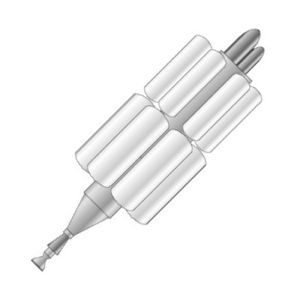
Home - Search - Browse - Alphabetic Index: 0- 1- 2- 3- 4- 5- 6- 7- 8- 9
A- B- C- D- E- F- G- H- I- J- K- L- M- N- O- P- Q- R- S- T- U- V- W- X- Y- Z
Faget Mars Expedition
 Mars NASA Lewis 1960 Faget Mars Expedition Credit: © Mark Wade |
Status: Study 1963.
It was found that, given the same assumptions regarding the separate lander vehicle, a Mars landing spacecraft could vary from 270 to 1140 metric tons in low earth orbit, depending on the type of propulsion and mission scenario.
Max Faget at NASA Langley began the first in-house studies of manned missions to Mars in mid-1961. This was a low-level effort until late 1962, after the move of Faget's team to Houston. Then, in order to match the work of Von Braun's EMPIRE studies at NASA Huntsville, NASA Houston decided to sponsor a conference in Denver, Colorado on 22-23 May 1963. The proceedings of this symposium were published by the American Astronautical Society as 'Manned Exploration of Mars'. This was the largest such meeting until the 1980's. Two Mars Orbit Rendezvous mission profiles were studied.
- The flyby-rendezvous method involved an unmanned flyby spacecraft, sent on a trajectory in a solar orbit with an aphelion beyond that of Mars and a 200 day transit time to the planet. A manned Mars Excursion Module spacecraft would be launched 120 days before the flyby spacecraft. It would land on Mars as the flyby spacecraft went past Mars toward aphelion. After 40 days on the surface, the flyby spacecraft would be returning past Mars on its way back to earth. The Mars Excursion Module would rocket the crew off the surface, past escape velocity, into solar orbit to rendezvous with the flyby spacecraft in deep space. The crew would transfer to the flyby spacecraft for the return home.
- The more conventional Mars Orbit Rendezvous profile involved a single spacecraft braking into Mars orbit, a lander descending to the surface, and then returning the crew to rendezvous and dock with the mother spacecraft in Mars orbit before returning to earth. However there were variations on this profile as well - with or without aerobraking to get the spacecraft into Mars orbit.
Spacecraft mass in earth orbit varied widely according to the profile. The heaviest would be a spacecraft using all chemical propulsion and rocket braking into Mars orbit -- 1140 metric tons. The lightest would be a nuclear-propelled spacecraft using aerobraking - 270 metric tons. A chemically-powered spacecraft using either the flyby/rendezvous profile or aerobraking at arrival would have a mass of 1000 metric tons.
The common Mars Excursion Module design used in these studies was a lifting body developed by Ford Aeronutronic in May-December 1963.
Faget Mars Expedition Chemical Mission Summary:
- Summary: NASA trade study showing worst case in terms of total mass
- Propulsion: LOX/LH2
- Braking at Mars: propulsive
- Mission Type: opposition
- Split or All-Up: split
- ISRU: no ISRU
- Crew: 6
- Outbound time-days: 280
- Mars Stay Time-days: 40
- Return Time-days: 310
- Total Mission Time-days: 630
- Total Payload Required in Low Earth Orbit-metric tons: 1140
- Mass per crew-metric tons: 190
- Launch Vehicle Payload to LEO-metric tons: 454
- Number of Launches Required to Assemble Payload in Low Earth Orbit: 3
- Launch Vehicle: Nova GD-H
Faget Mars Expedition NTR Split Mission Summary:
- Summary: NASA trade study showing best case in terms of total mass in low earth orbit; first to propose flyby/rendezvous scenario
- Propulsion: Nuclear thermal
- Braking at Mars: flyby-rendezvous
- Mission Type: opposition
- Split or All-Up: split
- ISRU: no ISRU
- Crew: 6
- Outbound time-days: 280
- Mars Stay Time-days: 40
- Return Time-days: 310
- Total Mission Time-days: 630
- Total Payload Required in Low Earth Orbit-metric tons: 270
- Mass per crew-metric tons: 45
- Launch Vehicle Payload to LEO-metric tons: 330
- Number of Launches Required to Assemble Payload in Low Earth Orbit: 1
- Launch Vehicle: Nova MM 1B
Family: Mars Expeditions. Country: USA. Bibliography: 591.
Back to top of page
Home - Search - Browse - Alphabetic Index: 0- 1- 2- 3- 4- 5- 6- 7- 8- 9
A- B- C- D- E- F- G- H- I- J- K- L- M- N- O- P- Q- R- S- T- U- V- W- X- Y- Z
© 1997-2019 Mark Wade - Contact
© / Conditions for Use